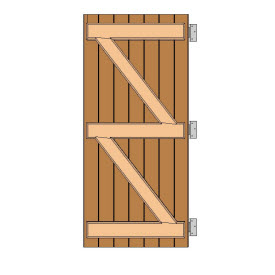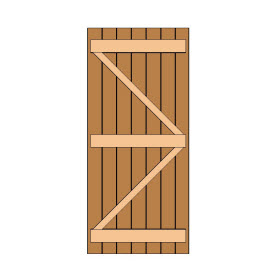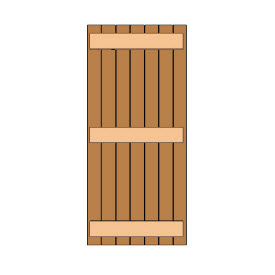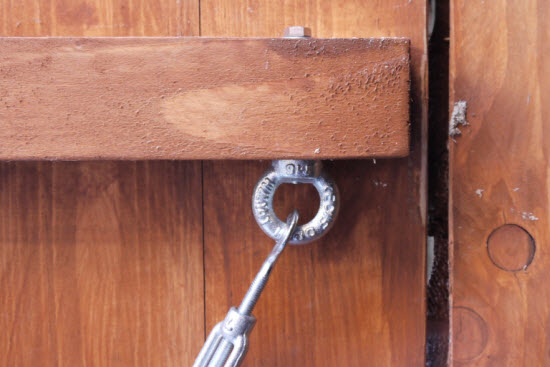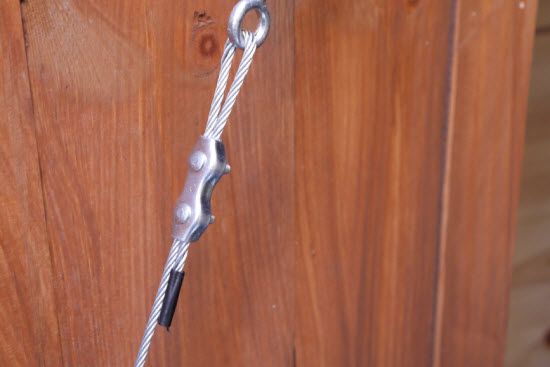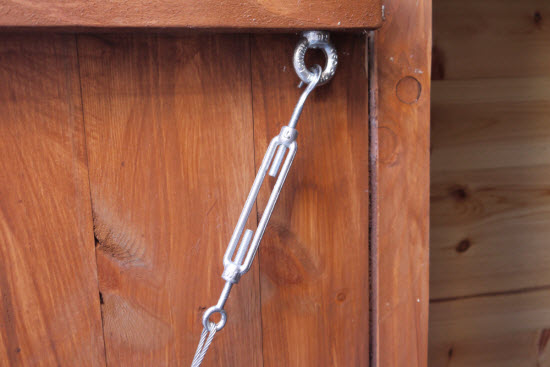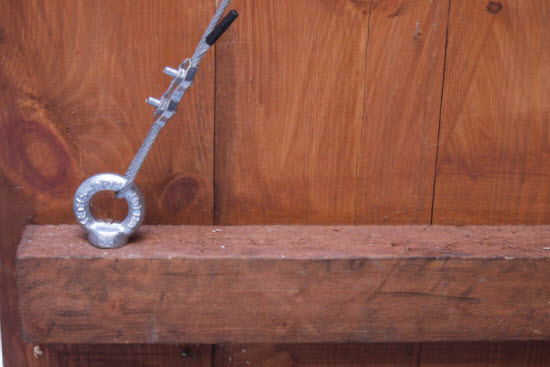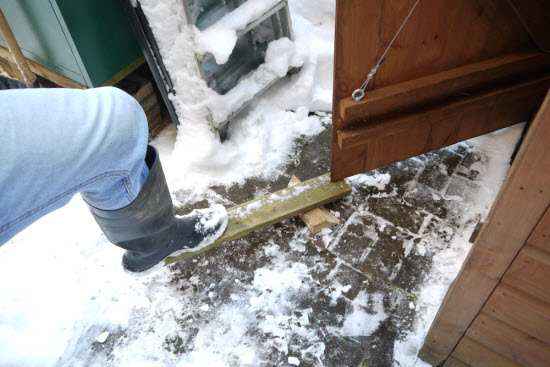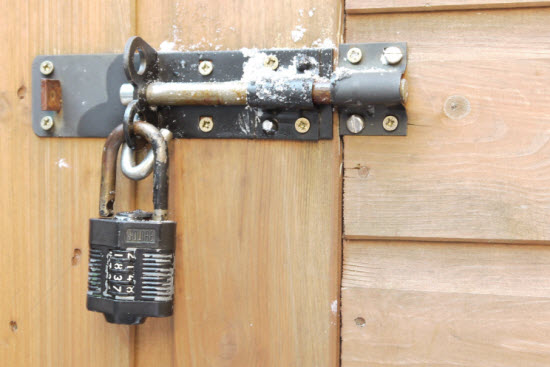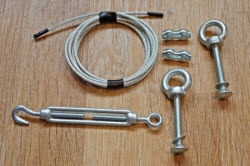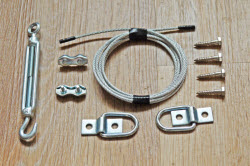Fixing a Sagging Shed Door - How to correctly diagnose and straighten a shed door so that you can lock it
The most likely cause of a sagging shed door is that it has a lack of bracing and has not been built correctly in the first place.
This is the process to follow to make sure that the following solution will work:
So let's have a quick look at the common types of shed door so that you can identify which type you have:

This is what a correctly built ledged and braced door looks like. There are two braces, with the lower edge of the brace on the same side as the hinges. The braces are 'housed' into the horizontal ledgers.

This is what most shed doors look like. The braces are in opposite directions so that it doesn't matter too much if someone fixes it the 'wrong way up'. Also the braces are not 'housed' into the ledgers. This door is cheaper to make than type 1. and not as stable.

And many look like this. In this one the braces have been completely omitted to save cost. This door is the most prone to sagging.
All three versions of the door work initially
Friction between the boards and the initial grip of the nails is good. Over time however, as the door is used and the wood gets wet and dries out a number of times. The connections loosen and you end up with a sagging shed door where the bolt won't pull across.
With door type 1 this doesn't happen. The timber expands and contracts most at right angles to the grain. In line with the grain the timber barely moves and the timber brace is notched into the horizontal door ledger. So the door remains stable.
With door type 2 the braces aren't notched in to the timber. Some ssagging may happen dependant on; the materials the door was built from, the age of the door, the fixings.
It is better than door type 3 but not as good as door type 1.
With door type 3 the nails loosen and the interlock of the boards loosens. There is no diagonal member to stop the door from sagging downwards.
Before you dive in to fix your sagging shed door
Take a step back to make sure you have correctly diagnosed the problem. You need to make absolutely sure that it is the shed door that has sagged rather than the frame of the shed which has distorted.
The way to check this is to use a spirit level. Check that the door stiles are vertical and the door header and threshold are horizontal.
If you find that the door frame members are not vertical and horizontal the solution is different to the procedure that I describe below.
|
To correct a distorted door frame may require you to lift or pull the shed frame back in to shape. Add your name to our monthly newsletter Shed Building Monthly to make sure you don't miss this article when it comes out. |
If the door frame is relatively square and you are happy that it is a sagging shed door and not a distorted door frame.
You can start to fix your sagging shed door problem
The simplest solution to this is to lift the outer edge of the shed door with a lever (see picture further down the page). You can then screw a piece of timber across one of the diagonals. Fix this diagonal brace to the horizontal ledgers. The timber brace will act in tension or compression so it doesn't matter too much which diagonal it is fixed across.
The problem with this method is it can be quite tricky to get the door to move just the right amount first time. Also, as the door expands and contracts you may have to undo the screws and re-fix each time the door comes out of adjustment.
A neater and more easily adjustable solution to fix a sagging shed door is to use a wire rope tension brace
This brace is simple to install and a breeze to adjust if (and when) the door moves again.
The brace comprises a strong but thin wire rope that stretches from an anchor point near to the top hinge down to the opposite bottom corner of the door. A turnbuckle within the wire rope is rotated to adjust the length and tension in the rope. This can pull the bottom of the sagging shed door up so that the door locking bolt is in alignment.
How to install an adjustable brace
The first step is to create anchor points on the top and bottom ledger of the door. The way I did it in the picture is to use an eye bolt brace which fixes vertically through the door ledger. This worked well with the dimensions of this ledger. If the ledger is wider and thinner you will need to order the lashing strap version of the shed door brace which fixes to the face of the ledger with a coach bolt.
 Drill hole through ledger 1mm larger than bolt fixing size.
Drill hole through ledger 1mm larger than bolt fixing size.
The wire rope is fixed to the turnbuckle through the eye using 'duplex' grips. These aren't as fiddly to tighten as the traditional bulldog grips and also look slightly better. They aren't as strong as bulldog grips but for this application the strength of the rope connection is not a critical factor. It is easy with these relatively small bolts to strip the threads so take care not to overtighten.
 View of wire rope grips
View of wire rope grips
The hook of the turnbuckle is hooked on to the upper fixing point.

The rope is then threaded through the lower anchor point and the loose end fixed back to the rope. At this point try to get the rope reasonably straight. But the main tension to hold the door in position is done with the turnbuckle.
 View of lower anchor point
View of lower anchor point
With the brace in position use a lever to lift the sagging door. I used a couple of pieces of 2x4. Adjust the length of the lever and gently use your body weight to raise the outer edge of the door to the point where door bolt aligns to the correct position.
 Using a wooden lever and fulcrum to lift the outer edge of the door.
Using a wooden lever and fulcrum to lift the outer edge of the door.
Use some oil to get the door bolt to move easily and also slow down future corrosion.
 View of completed bolt. With oil and post-fixing snowball. Thanks kids! ;-)
View of completed bolt. With oil and post-fixing snowball. Thanks kids! ;-)
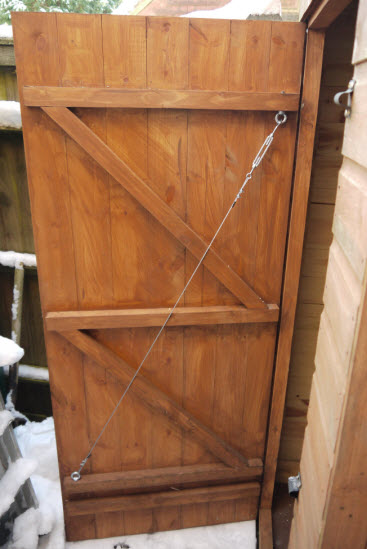 View of shed tension brace, holding door nicely in position
View of shed tension brace, holding door nicely in position
Et voila! Your previously sagging shed door can now be locked shut again. And if/when the timber swells or shrinks you can easily adjust the door.
It all sounds so simple, what sorts of problems could you expect to encounter?
One problem could be that the timbers of your shed door are too rotten. The forces generated in a brace aren't huge but if the door is rotten it really is time to either buy or make yourself a new shed door.
Another problem is that the door won't move as the timber is too wet and swollen. The solution to this is to install the brace and gently tension. Then wait as the door dries out.
Controlling the moisture content of the timber in the shed door is the best way to limit future movement. Use a water repellent wood preservative to help stop rain and general dampness from the weather from causing the timber to swell. Also a door cap over the entrance protects the top edge of the door from driven rain.
In summary to fix your sagging shed door
Firstly check what type of door you have and if it is particularly prone to sagging.
Next, check the verticality of the door frame and make sure that you have correctly diagnosed your problem.
Choose an adjustable brace below to align the door
Use a water repellent wood preservative to stabilise the movement of your door.
To Order The Shed Door Brace Kit:
Choose which type you need:
Eyebolt door brace: The type in the article is for door battens 50x50mm square
Lashing strap door brace: Surface fixing for door battens that are more like boards
|
1. Eyebolt shed door brace Price: £12.50 (UK Only)
|
|
2. Lashing strap shed door brace Price: £12.50 (UK Only)
|

Looking for more information on how to get your shed door working perfectly?
Return from Sagging Shed Door to the Shed Door Hardware hub page

Keep in touch with our monthly newsletter
Shed Building Monthly
